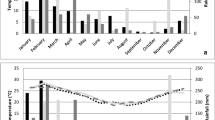Summary
The performance of Nguni, Bonsmara and Hereford oxen which were maintained free of ticks by short interval treatment with acaricide irrespective of tick load (tactical) was compared with similar groups which were treated for tick infestation only when the numbers of adult ticks on the cattle increased to moderately high proportions (strategic). Strategically treated Nguni oxen acquired a strong resistance against ticks and showed weight gains comparable with the tick free Nguni group. Weight gains in the Bonsmara group were higher in the strategically treated group suggesting a possible effect of the acaricide on the tick free group. Strategically treated Hereford oxen acquired heavy tick burdens and performed poorly compared with the tick free group. Practical approaches to strategic tick control under African conditions are discussed.
Résumé
Les performances des boeufs de races Nguni, Bonsmara et Hereford, maintenus indemnes de tiques par des traitements acaricides répétifs, quelle que soit la charge parasitaire, (méthode tactique) ont été comparées à celles de groupes d'animaux identiques, également traités contre les ixodes, mais uniquement lorsque le nombre de tiques adultes atteignait des proportions modérement (ou moyennement) élevees (méthodes tratégique). Les boeufs Nguni traités par la méthode stratégique ont acquis une forte résistance aux tiques et ont montré des gains pondéraux comparables à ceux du groupe Nguni traités par la méthode tactique. Les gains de poids dans le groupe Bonsmara ont été plus élevés pour les animaux traités avec la méthode stratégique, ce qui pourrait signifier un effet possible de l'acaricide sur le groupe traité par voie tactique. Enfin, les beoufs Hereford traités par la méthode stratégique ont été fortement infestés par les tiques et leurs performances assez pauvres comparées à celles du groupe traité par la méthode tactique. Les approches pratiques de la maîtrise stratégique des tiques dans les conditions africaines font l'objet d'une discussion.
Resumen
Se comparó, la productividad general de novillos Nguni, Bonsmara y Hereford, que se mantuvieron libres de garrapatas mediante tratamientos repetidos con acaricida, sin tener en cuenta la infestacíon por garrapatas (tratamientos tácticos), con aquella de grupos similares, que fueron tratados cuando el número de garrapatas adultas ingurgitadas fue moderado o alto (baños estratégicos). Los novillos Nguni tratados estratégicamente, adquirieron una fuerte resistencia a infestación por garrapatas, mostrando aumentos de peso comparables con aquellos del grupo Nguni tratado tácticamente. La ganancia de peso fue superior en el grupo Bonsmara, fue superior en el grupo tratado estratégicamente, sugiriendo un posible efecto del acaricida, sobre el grupo bajo tratamiento táctico. El grupo Hereford tratado estratégicamente, adquirió mayor número de garrapatas y tuvo aumentos de peso inferiores; que el grupo tratado tácticamente. Se discuten metodologías apropiadas, para el control estratégico de garrapatas, bajo condiciones africanas.
Similar content being viewed by others
References
Acocks, J. P. H. (1975). Veld types of South Africa. Memoirs of the botanical survey of South Africa, No. 40. Department of Agricultural Technical Services, South Africa. p 128.
Amerault, T. E. &Roby, T. O. (1968).Journal of the American Veterinary Medical Association,153, 1828–1834.
Brown, C. C., Logan, L. L., Mebus, C. A. &Nagarski, K. (1989).Tropical Animal Health and Production,21, 100–106.
Callow, L. L. &McGregor, W. (1970).Australian Veterinary Journal,46, 195–200.
Fivaz, B. H. &Norval, R. A. I. (1990).Experimental and Applied Acarology,8, 51–63.
Fivaz, B. H., de Waal, D. T. &Lander, K. (1992).Tropical Animal Health and Production,24, 81–89.
Hewetson, R. W. (1981).Tick Biology and Control. (Eds G. B. Whithead and J. D. Gibson). Tick Research Unit, Rhodes University, Grahamstown, South Africa. pp 79–85.
Joyner, L. P., Donnely, J., Payner, R. &Brockelsby, D. W. (1972).Research in Veterinary Science,13, 515–518.
McCosker, P. J. (1979).Recent Advances in Acarology,2, 45–53.
Meyer, E. H. H. (1984). Proceedings of the 2nd World Congress on Sheep and Beef Cattle Breeding (Eds J. H. Hofmeyer and E. H. H. Meyer). 16–19 April 1986. Pretoria, South Africa.
Norval, R. A. I. (1983).Zimbabwe Veterinary Journal,14, 19–25.
Norval, R. A. I., Sutherst, R. W., Kurki, J., Gibson, J.D. &Kerr, J. D. (1988a).Veterinary Parasitology,30, 149–164.
Norval, R. A. I., Sutherst, R. W., Jorgenson, O., Gibson, J. D. &Kerr, J. D. (1988b).Veterinary Parasitology,33, 329–341.
Pegram, R. G., Lemche, J., Chizyuka, H. G. B., Sutherst, R. W., Floyd, R. B., Kerr, J. D. &McCosker, P. J. (1989).Medical and Veterinary Entomology,3, 313–320.
Rechav, Y. (1982).Journal of Medical Entomology,19, 679–700.
Rechav, Y. (1987).Experimental and Applied Acarology,13, 219–232.
Scholtz, M. M. (1988). Proceedings of the 3rd World Congress on Beef and Beef Cattle Breeding, 19–23 June 1988, INRA, Paris.2, 303–319.
Scholtz, M. M., Roux, C. Z. &Lombard, P. E. (1990). Proceedings of the 4th World Congress on genetics applied to livestock Production. (Eds W. G. Hill, R. Thompson and J. A. Woolliams). 23–27 July 1990, Edinburgh, Scotland.16, 361–364.
Scholtz, M. M., Spickett, A. M., Lombard, P. F. &Enslin, C. B. (1991).Onderstepoort Journal of Veterinary Research,58, 71–74.
Spickett, A. M., de Klerk, D. D., Enslin, C. B. &Scholtz, M. M. (1989).Onderstepoort Journal of Veterinary Research,56, 245–250.
Sutherst, R. W., Wharton, R. H., Cook, I. M., Sutherland, I. D. &Bourne, A. S. (1979).Australian Journal of Agricultural Research,30, 353–368.
Sutherst, R. W. (1981).Tick Biology and Control. (Eds G. B. Whitehead and J. D. Gibson). Tick Research Unit, Rhodes University, Grahamstown, South Africa. pp 79–85.
Tatchell, R. J., Chimwari, D., Chirchir, S. J., Ongare, J. O., Mwangi, E., Rinkanya, F. &Whittington, D. (1986).The Veterinary Record,119, 401–403.
Taylor, R. J. &Plumb, I. R. (1981).Tick Biology and Control. (Eds G. B. Whitehead and J. D. Gibson). Tick Research Unit, Rhodes University, Grahamstown, South Africa. pp 21–28.
van der Merwe, L. (1979).Journal of the South African Veterinary Association,50, 323–325.
Author information
Authors and Affiliations
Rights and permissions
About this article
Cite this article
Fivaz, B.H., de Waal, D.T. An evaluation of strategic and short interval tick control in indigenous exotic and crossbred cattle. Trop Anim Health Prod 25, 19–29 (1993). https://doi.org/10.1007/BF02236881
Accepted:
Issue Date:
DOI: https://doi.org/10.1007/BF02236881




